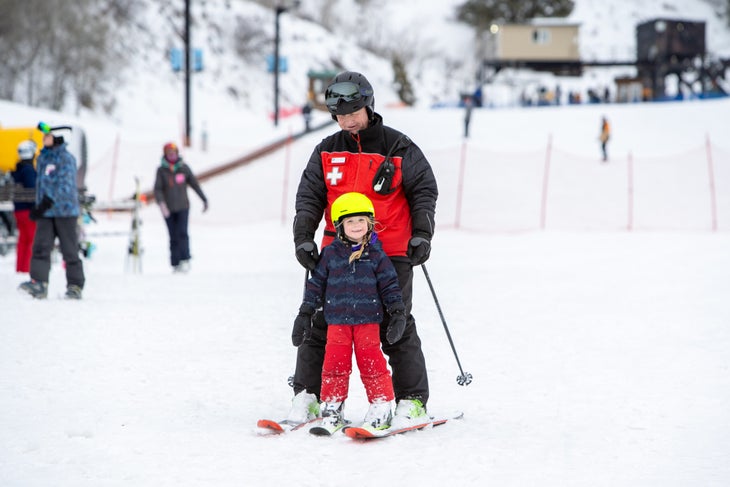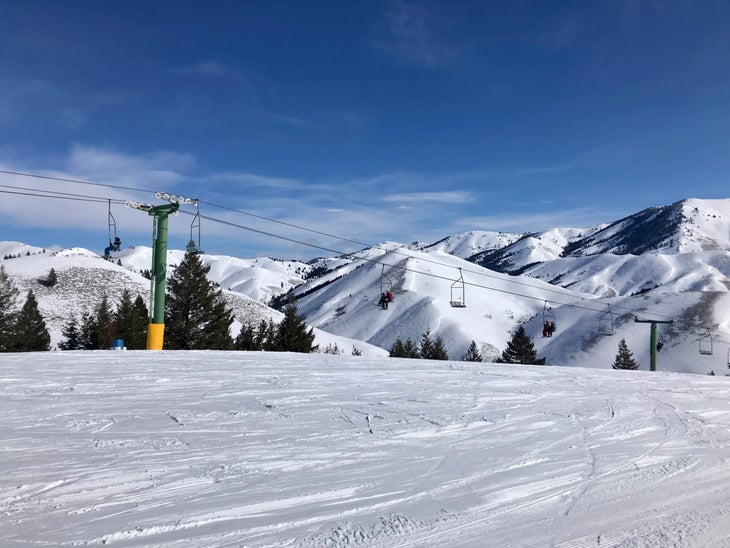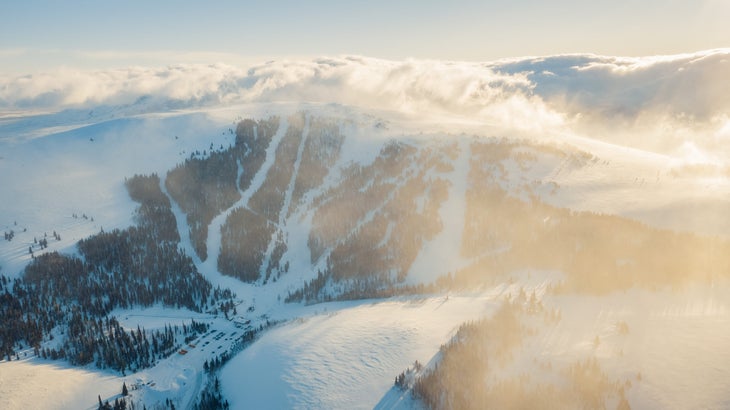Heading out the door? Read this article on the new Outside+ app available now on iOS devices for members! Download the app.
Nostalgia surged over me as I stood in the lift line at Kelly Canyon, a community ski area in east Idaho. Students were noisily tromping out of a yellow school bus, the town’s after-school ski club, swarming the lanes with the squeals and dramatic exclamations common to joyous middle-schoolers everywhere. A father passed by, hefting his toddler in one arm and hauling both sets of skis as she urged him to speed up toward the magic carpet line. My father had done the same for me. My early adolescence was also filled with school trips to a local ski hill, especially when my Plains city got a blast of true powder. It hit me that this was how most of us fell in love with the sport, at ski areas designed for family budgets.

Family-owned and independent ski areas—the mom-and-pop ski slopes of the sport—get less of the spotlight than the mountain resorts with iconic names. Yet they’re an essential part of the industry across the country, teaching new generations of skiers and snowboarders with affordable daily rates and strong school programs. A new ruling in Idaho threatens these community anchors and may topple a domino of precedents beyond state lines.
The issue comes down to personal liability and insurance. The case is well-documented: In November of 2019 at Sun Valley, Stewart Milus skied across the backs of another person’s skis on a moderately crowded groomed run and crashed into a yellow-padded snowmaking tower gun. Tragically, he died from his injuries. His widow sued Sun Valley for lack of adequate signage warning of the hazard in the run. In December of 2023, the Idaho Supreme Court overturned the lower court’s interpretation of the 1979 Ski Area Liability Act.
Previously, personal indemnification has been key across the states—skiers and snowboarders acknowledge the inherent risk and agree to long-held codes of conduct. “Historically, it has been understood that skiing is driven by personal responsibility,” says David Alden, general manager of Idaho’s Soldier Mountain. “We are all in this together.”
The 2023 Idaho Supreme Court decision changed course, citing that regardless of a skier’s actions, a jury should be able to consider a resort’s blame—in this case whether the yellow padding was adequate warning. The court will hear reconsideration arguments in Boise on February 14, 2025.

If their decision stands, ski areas in the Gem State will anxiously wait for new liability insurance quotes—many already reported a 12 percent or more increase this year without the ruling finalized. More than half of the state’s ski areas are nonprofits or family-owned ski areas that don’t have the corporate backing to sustain skyrocketing costs.
“It’s important to note how much ski areas already do to create a safe place for people to recreate,” says Alden. “If that’s not enough…there is not much more we can do.” Alden concedes they are then at the mercy of rising insurance costs on what he called an already “catastrophic trajectory.”
Also Read: Save Money, Ski Big: 6 Resorts Under $75 with Serious Vert
Skiers and snowboarders in the Northeast have seen this fallout before. In 1978, the Vermont Supreme Court found Stratton Mountain responsible for a skier’s paralyzing fall after his skis tangled in brush on the trail’s edge. Over the following decades, as climbing liability exceeded gross revenues, many of the state’s small ski areas closed. The ruling changed how other states approached safety through safety practices and regulations. This current precedent from Idaho may have a national fallout as well.
“Given how unique ‘ski law’ is to a few dozen states, when there is a bad ruling or verdict in Idaho, it can profoundly reverberate to places like Vermont and New Mexico,” says Dave Byrd, the director of risk and regulatory affairs for the National Ski Areas Association (NSAA).
For larger ski areas, passing on costs to guests is the answer. But smaller resorts that open up access with more affordable rates—less than $60 a day—risk alienating the community they serve. “A $5 to $10 difference on Soldier Mountain has a huge impact on skiers here,” says Alden.
Gretchen Anderson, marketing director at Pomerelle, a family-run ski area in Idaho, understands what is at stake. Pomerelle has been in her family since the 1970s, and they pride themselves on offering affordable skiing and learning facilities. “We are literally the epitome of a mom-and-pop operation, a small resort that is here for the purity of the sport.” Anderson chuckles as she thinks of the parents who fight to chaperone the school trips for the great rate. “Idaho learns how to ski at these little, family places.”

Alden sees the same at Soldier Mountain, where tens of thousands of guests have learned to ski in 77 years of consecutive operation. He also quickly lays bare the potential impact on employment. “We’re talking thousands of kids working here over the years. Third and fourth generation kitchen workers, instructors, lifties, patrol,” Alden pauses and grapples with the impact. “This is all at risk. This is a fundamental part of the community.”
Erik Mogensen, founder and managing director of Indy Pass and parent company Entabeni Systems, sees a more insidious threat beyond decisions in Boise.
Related: He Loves Small, Independent Ski Areas So Much, He Bought One
“The problem is not the [Idaho] Supreme Court decision. There is no such thing as total indemnification for resorts. The problem is [the breakdown of] insurance.” Mogensen describes the lack of reasonable insurance choices across industries, driven by astronomical costs, incomplete data, and missing service operators. “The options for smaller independents are shrinking.”
The NSAA sees insurance hits twice over with rising wildfire risks also sending property insurance premiums through the roof. “These smaller independent ski hills are so critical to local rural communities and families,” says Byrd. “We need to protect their long-term viability.”
Mogensen reports Entabeni and Indy Pass have already been working on a path to help ski slopes band together and insure themselves. The team bought Black Mountain in New Hampshire, saving it from closure and working towards an eventual co-op model.
“A lot of resorts want to help figure this out and there are talented operators that really care about independent operators and the sport,” emphasizes Mogensen. “There’s hope.”